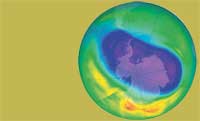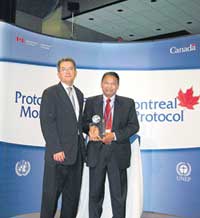
Healing the holeThe fight to protect the Ozone layer: Sri Lanka wins UNEP award When “Ozone-friendly”, “CFC free” labels started to appear in the early ’90s on products such as refrigerators, to many, it seemed just another marketing strategy, but in fact, these “ozone-friendly” alternatives may save lives. Skin cancer, cataracts and problems in the immune system are some of the effects of exposure to dangerous Ultra Violet (UV) rays that penetrate Ozone Holes in the atmosphere. Scientists identified the threat caused by the depletion of the Ozone Layer that shields the earth, by gases such as Chloro fluoro carbons (CFCs) in the early ’80s. Knowing the grave consequences, the global community initiated the Vienna Convention for the Protection of the Ozone Layer in 1985. As the legal instrument for the Vienna Convention, the Montreal Protocol on Substances that Deplete the Ozone Layer came into force in 1987.
Being a Third World country, one might be forgiven for thinking that Sri Lanka would lag behind in achieving such international commitment. But to the contrary, the National Ozone Unit (NOU) of Sri Lanka has driven all parties to achieve the Montreal targets ahead of the allotted time. In recognition of their efforts, the NOU received the award for Best Implementers of the Montreal Protocol last week at a ceremony in Montreal, Canada that celebrated the 20th Anniversary of the Protocol. The citation on the award given by the UNEP read - “Sri Lanka Ozone Unit known globally for many of its contributions to efforts to address Ozone Depleting Substances (ODS) including its effective implementation projects to enable achievements of the Protocol’s reduction requirements, its effective licensing programs and its creative public awareness activities.” Dr. W.L. Sumathipala, head of the NOU, who just returned from Canada with the award, praised the parties that have been supporting them in the fight to protect the Ozone Layer. Sri Lanka ratified both the Vienna Convention and the Montreal Protocol on December 15, 1989. The Montreal Protocol has been signed by 192 countries at present. Each country has been given a set of annual targets to reduce the usage of ODS depending upon the base levels and with a deadline of complete elimination by 2010. The NOU of Sri Lanka was established under the Ministry of Environment in 1994, to implement the Montreal Protocol and related activities. Initially called the Montreal Protocol Unit, it was later named the National Ozone Unit. The 13th summit of Montreal Protocol countries was held in Colombo and Sri Lanka was nominated as the president of the Bureau of the Montreal Protocol countries for 2001 and has been vice president both in 2000 and 2005. Fulfilling the commitments under the Montreal Protocol on Substances that Deplete the Ozone Layer by phasing out ODS has been adopted as the primary mission of the NOU since its inception. To initiate activities to maintain and strengthen the institutional framework in protection of the Ozone Layer, with minimum inconvenience to industry/general public are the other objectives of this unit. NOU assists local industrialists and individuals to convert their equipment into CFC-free systems by providing funds as well as technical guidance. The training unit of NOU regularly conducts workshops for technicians and students on methods of modifying existing machinery by using Ozone-friendly gases. Over 2300 technicians have been trained up to now. They also provide guidance in the reusing of the ODS which can reduce the gases being freely released into the atmosphere.
Sri Lanka imported over 450 tonnes of CFCs in 1995 and this was reduced by 85% in 2006. The NOU hopes to eliminate some of the Ozone Destruction Substances completely from Sri Lanka by 2008, two years prior to the target set by the Montreal Protocol. Although Sri Lanka is not producing Ozone Depleting Substances within the country, a few industries consume significant amounts of ODS. Air conditioning, the refrigerator service sector, the agricultural sector and quarantine sector are the main industries. CFC, which is the main ODS has been heavily used in the refrigeration and air conditioning sector. There were three refrigeration factories using CFCs in Sri Lanka, but these were converted to non-CFC technology with grants from the Multilateral Fund. At present CFCs are being used only for repairing and servicing of refrigerators, air conditioners etc. NOU encourages recycling of these substances. ODS is also used in the garment manufacturing industry on a small scale as a solvent, and for dry-cleaning textiles. Bromine compound is another substance that depletes Ozone. Halons which contain these bromine compounds are used in fire extinguishing equipment. No virgin Halon is being imported to the country now; but there is a possibility of the use of already installed systems. Methyl Bromide (CH3Br) is imported as a pre-shipment fumigant and is used as a soil treatment to control soil pests such as nematodes, seeds fungi, bacteria and other parasite plants. In Sri Lanka Methyl Bromide is commonly used in the tea plantations. NOU has collaboratively worked with the Tea Research Institute to introduce alternatives for these, supported by the. UNEP and UNDP. NOU also conducts awareness programmes for students and the general public. The world community has not yet felt the full impact of ozone depletion. September 16th has been set apart as the International Ozone Day and 2007 was named the International Year for Ozone Protection by the UN to emphasize the importance of the effort. However, countries like Sri Lanka will feel the effects of the changes caused by Ozone Depletion, aggravated by poor health conditions, undeveloped agricultural methods and other economic setbacks unless preventive action is taken. This is where the efforts by the NOU are so vital.
|
|| Front
Page | News | Editorial | Columns | Sports | Plus | Financial
Times | International | Mirror | TV
Times | Funday
Times || |
| |
Reproduction of articles permitted when used without any alterations to contents and the source. |
© Copyright
2007 Wijeya
Newspapers Ltd.Colombo. Sri Lanka. All Rights Reserved. |

